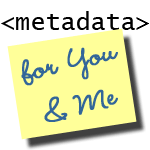Metadata for You & Me - Defining Shareable Metadata: Communication
Module Content
Screencast
Powerpoint Slides and Other Resources
- Download PowerPoint
- Library of Congress: OAI-PMH Set Descriptions
- Library of Congress: OAI-PMH Information Page
- National Library of Australia: OAI-PMH Information Page
Module Text
1. Better communication to achieve shareable metadataCommunication between metadata providers and aggregators is key to ensuring metadata is shareable. This communication can happen both within a given sharing protocol (for example, the <about> container in OAI-PMH) and outside of it.
Consider documenting and sharing the following information with aggregators:
- Intended audiences
- Record creation methods
- Controlled vocabularies used
- Content standards used
- Accrual practices
- Existence of analytical or supplementary materials
- Provenance of materials
In the OAI-PMH protocol, set descriptions can be used to document practices related to that group of materials. The Library of Congress makes extensive use of OAI-PMH set descriptions.
If you are sharing with a method other than OAI-PMH, or you are using an OAI-PMH data provider that does not support the optional set description, you can still provide information to aggregators. The National Library of Austrialia has documented on a simple Web page information that is useful to aggregators. Even if you are using OAI-PMH, you might consider a more human-readable form of the information available in set descriptions. The Library of Congress provides an example of this approach. What else might an institution add to the information presented on these pages?
3. What to look for in specific element typesIf you can use a metadata format that allows you to communicate information about the vocabularies and encoding schemes in use, do so. Some of the digital library systems in use do not allow the use of more complex metadata formats; in those cases, as stated above, use a web page or some other way to communicate with users.
Some specific elements where it is useful to have information about the vocabulary or encoding scheme in use are: date, subject, name, type of resource, geographic names, format, genre, and temporal coverage.
Next module: Defining Shareable Metadata: Consistency



